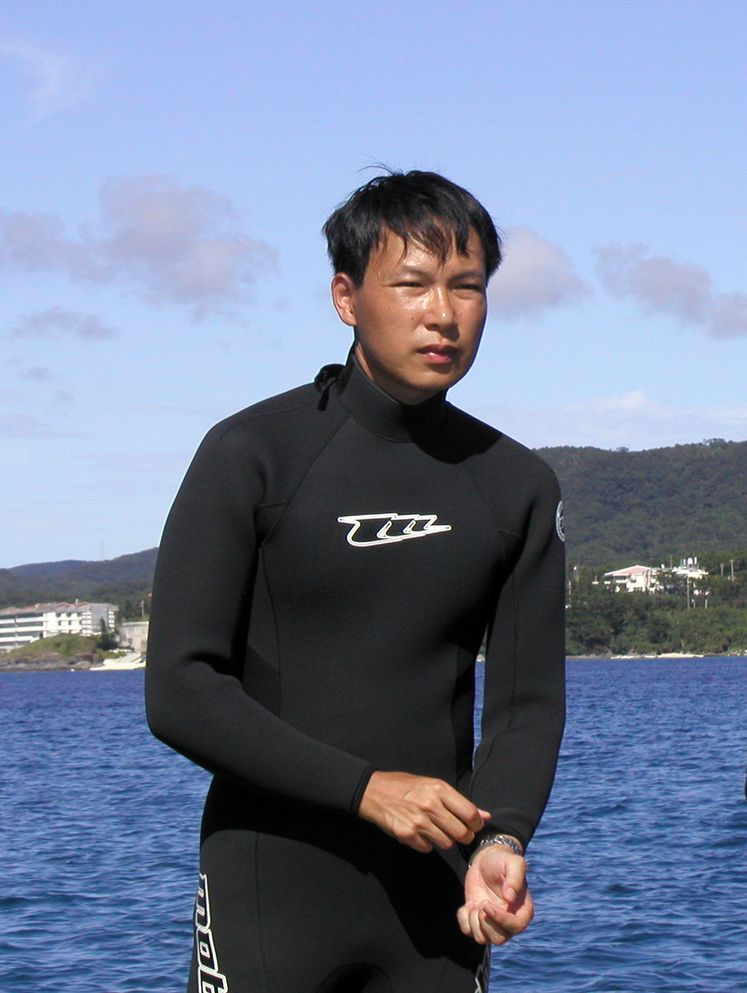 | Born in 1968 in (Japan) Lives and works in (République socialiste du Viêt Nam ) | Biographie Bibliographie Liste expositions |
 | Born in 1968 in (Japan) Lives and works in (République socialiste du Viêt Nam ) | Biographie Bibliographie Liste expositions |
His work mainly consists of videos and installations, to which he also associates performance. Water and sea are integral parts of Vietnam, with its long coastline. They are also the essential elements of Jun Nguyen-Hatsushiba's work. In Memorial Project Nha Trang, Towards the Complex – For the Courageous, the Curious, and the Cowards, dating from 2001, the artist films a performance under the sea, as in many of his videos and installations. This video was made in Vietnam, in the Indochina Sea, in the bay of Nha Trang.
The installation takes the form of a screening of a 13-minute video in a dark room. We see six fishermen dive, then, two by two, push and pedal three rickshaws at the bottom of the turquoise water, between the coral and rocks, then rise to the surface to catch their breath. The water gets deeper and deeper, the ascents are longer and the task becomes increasingly arduous: the pedal-powered rickshaws are the laboriously displaced, metre by metre. The complexity of the action contrasts with the beauty of the sea, its colours, and the light mirrored in the water. The slow motion effect caused by filming underwater accentuates the gracefulness of the movements of the fishermen that become choreography, while the shooting conditions also hamper their progress.
The music of Quoc Bao accentuates the hypnotic aspect of the video; the camera regularly films the air bubbles that rise to the surface and the sounds of the six fishermen's breathing, so that we can share the difficulty of the performance.
Vietnamese rickshaw drivers usually transport goods (rice, noodles, newspapers etc.) or people and this role is a source of income for many unemployed people. Pedal-powered rickshaws are a traditional means of transport in Vietnam and reflect the history of the country: at the end of the Vietnamese conflict, many soldiers became rickshaw drivers. However, modernisation has made these bicycles outmoded with respect to motor vehicles and the government is trying to limit their proliferation in major cities.
The rickshaws drivers rise slowly to the surface to catch their breath and eventually abandon their rickshaws and swim together towards the surface of the water. The camera continues its trajectory in the turquoise water, ending up in an underwater city made up of rectangular mosquito nets attached to rocks.
This underwater city is a metaphor in homage to the many Vietnamese boat people who died after the war. The term “boat people” appeared in the late 1970s with the mass departure of the Vietnamese refugees leaving the Communist regime founded at the end of the war. The new Communist government sent one million Vietnamese who supported the former regime in the South to “re-education camps”. According to American and European studies, 165 000 people died in these camps. These factors, along with poverty, caused many Vietnamese to flee the country by sea, attempting to get into international waters in order to be picked up by boats, or to reach Malaysia, Thailand, the Philippines and Hong Kong. The mosquito nets dancing in the water represent the tombs of the thousands of Vietnamese who perished in their attempt to escape.
Elodie Vouille